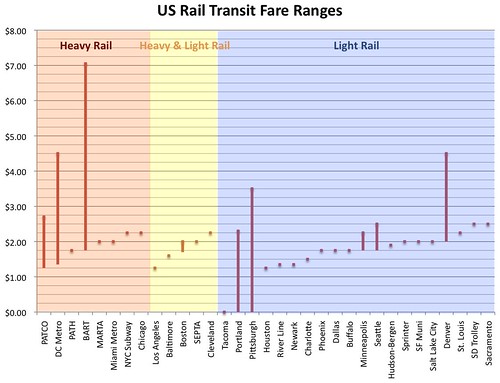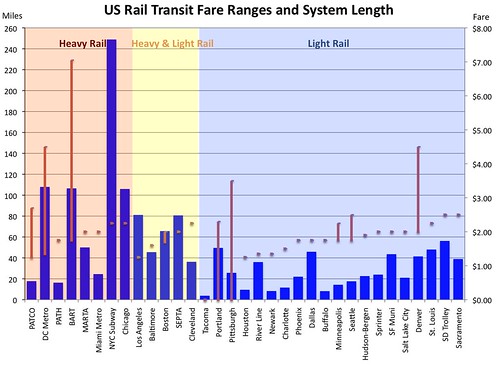*Please see below for a correction.
The recent economic hardship in the United States has created major budget problems for most, if not all, transit agencies in the country. As a result, many have raised fares in the past few months or are considering such a move. This week, Transit Tuesday takes a look at heavy and light rail transit fares around the nation.
Systems have been divided into three categories: Those operating heavy rail, those operating light rail, and those operating both. Because commuter rail operators typically have different fare policies, they were not considered in this analysis.

Note: This chart contains an error. The highest fare on BART is actually $10.90.
Among heavy rail (only) operators, the lowest fare is found on Philadelphia's PATCO Speedline, which has a graduated fare system based on distance traveled. The shortest trips cost $1.25, however, longer trips can cost as much as $2.70. The highest flat fares are found in New York and Chicago, where access to the Subway and the L costs $2.25. The honor of highest fare goes to BART in the San Francisco Bay Area. The longest trip results in a fare of $7.05 $10.90, however shorter trips can cost as little as $1.75.
Among operators of mixed systems, the lowest fare can be found in Los Angeles, where Metro charges a $1.25 flat fare. The highest flat fare is found in Cleveland, where it costs $2.25. Boston charges a flat fare, but charges different rates for customers using their RFID Charlie Card: $1.75 with the card, $2.00 cash or magstripe card.
Light rail (only) operators also see quite a range. Sound Transit's Tacoma (Washington) Link is a free service, so it holds the title of cheapest light rail. Portland and Pittsburgh both have fare-free areas downtown, but do charge for trips outside of that area - in Pittsburgh, as much as $3.50 during rush hours. Denver's RTD has the highest possible fare at $4.50, but it ranges as low as $2.00 for shorter trips. The highest flat fares are found in San Diego and Sacramento, where each ride costs $2.50.

The amount of access to the transportation system per cost is probably the best measure of value. This (brief) analysis does not consider how far one can travel per actual unit of fare, but the above chart does show the total rail system length in miles. Compare Washington's Metro with BART. The DC Metro is actually slightly longer (by about a mile). For $4.50, you can travel from end to end on the Metro, but the same trip on BART costs $7.05.
New York and Chicago have the same flat fare, but the New York Subway has more that twice as much mileage as the L. Among light rail operators, Portland and Pittsburgh offer contrast. With less than half the mileage of Portland's MAX, the Pittsburgh T has a maximum fare over 50% higher than the one found in Oregon. In addition, all of Pittsburgh's light rail lines are in the same general area of the region (south), whereas Portland's 52 miles of light rail are spread more evenly through the metropolitan area.
Among operators of mixed systems, the lowest fare can be found in Los Angeles, where Metro charges a $1.25 flat fare. The highest flat fare is found in Cleveland, where it costs $2.25. Boston charges a flat fare, but charges different rates for customers using their RFID Charlie Card: $1.75 with the card, $2.00 cash or magstripe card.
Light rail (only) operators also see quite a range. Sound Transit's Tacoma (Washington) Link is a free service, so it holds the title of cheapest light rail. Portland and Pittsburgh both have fare-free areas downtown, but do charge for trips outside of that area - in Pittsburgh, as much as $3.50 during rush hours. Denver's RTD has the highest possible fare at $4.50, but it ranges as low as $2.00 for shorter trips. The highest flat fares are found in San Diego and Sacramento, where each ride costs $2.50.

The amount of access to the transportation system per cost is probably the best measure of value. This (brief) analysis does not consider how far one can travel per actual unit of fare, but the above chart does show the total rail system length in miles. Compare Washington's Metro with BART. The DC Metro is actually slightly longer (by about a mile). For $4.50, you can travel from end to end on the Metro, but the same trip on BART costs $7.05.
New York and Chicago have the same flat fare, but the New York Subway has more that twice as much mileage as the L. Among light rail operators, Portland and Pittsburgh offer contrast. With less than half the mileage of Portland's MAX, the Pittsburgh T has a maximum fare over 50% higher than the one found in Oregon. In addition, all of Pittsburgh's light rail lines are in the same general area of the region (south), whereas Portland's 52 miles of light rail are spread more evenly through the metropolitan area.
Of course, this is just a (very) simple analysis. Many other factors play into the cost of transit fares. Still, it's an interesting look at what everybody else has to pay for a ride on the train.
**Correction: This article initially included an error, for which I apologize.
In my analysis of fares, I used the longest-distance trip on BART to calculate the highest fare, because BART does not list the highest fare on their website. The trip I used for the calculation was between Millbrae and Pittsburg/Bay Point. That trip, which passes through San Francisco Airport station costs $7.05. However, a trip from San Francisco Airport to Pittburg/Bay Point costs $10.90. This is due to a surcharge added to trips to/from SFO Airport Station. I have not updated the charts. Thanks to DavidJ for the tip.
Again, I apologize for the bad data. I do my best to provide accurate and informative data, and will continue to do so. If you see something you think is an error, please notify me.










2 comments:
Nicely done. I did a similar analysis a few months ago, but I think yours is probably a more accurate way to interprete these fares.
Re BART's charted maximum of $7.05, I was charged over $8 for BART rides to/from the SFO airport station last week. Possibly there's a surcharge for that station, but if a downtown "fare-free" zone is going to count as a fare of $0.00, the full fare, surcharges and all, to any station should be part of the mix.
But maybe it's just that they raised fares since the data was compiled.
Post a Comment